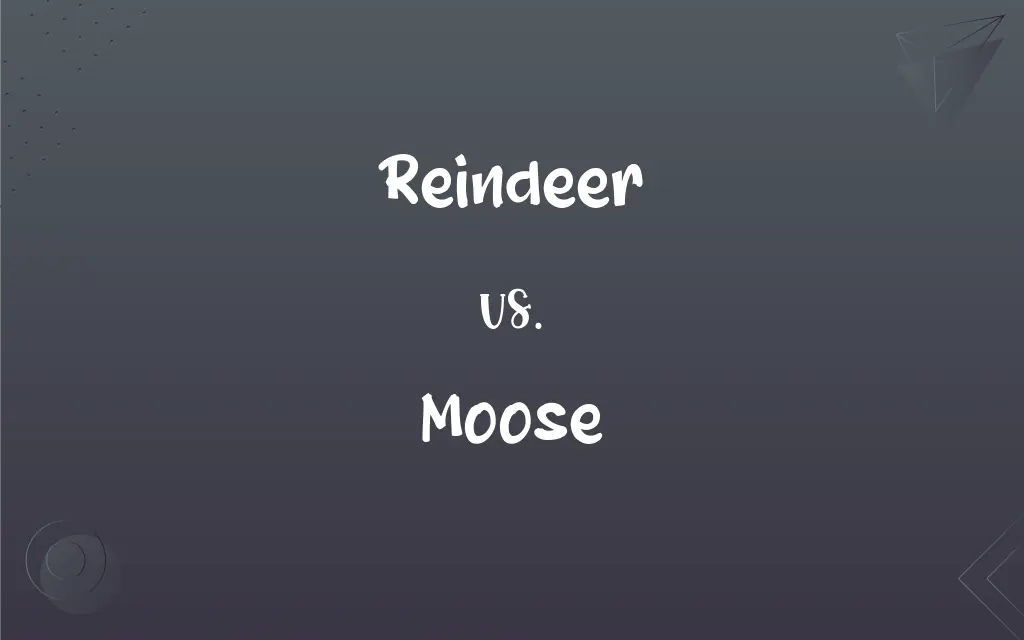Reindeer vs. Moose: What's the Difference?
Edited by Aimie Carlson || By Janet White || Updated on October 11, 2023
A "Reindeer" is a domesticated deer species used by Arctic people for transport, while a "Moose" is the largest deer species, characterized by its broad, flat antlers and long snout.

Key Differences
Reindeer and Moose are both members of the deer family, but they display distinct differences that set them apart. Reindeer, known scientifically as Rangifer tarandus, are notably smaller and are often associated with Arctic and sub-Arctic regions. They have a strong connection to human cultures in these areas, particularly with the Sami people of Northern Europe. Moose, on the other hand, are the giants of the deer family. Known scientifically as Alces alces, they inhabit forested areas in the Northern Hemisphere.
When discussing physical characteristics, the Reindeer has a more compact body with shorter legs, and both males and females have antlers. Their fur is dense, helping them stay warm in frigid temperatures. The Moose, in contrast, boasts a tall stature with long legs, a humped shoulder, and a long snout. Only male moose have antlers, which are broad and flat, making them easily distinguishable.
Behaviorally, Reindeer often move in large herds and have been domesticated by some indigenous cultures for transport, milk, and meat. Their migratory patterns are quite extensive, covering long distances in search of food. The Moose, being solitary animals, do not migrate in herds. They are browsers and primarily feed on leaves, twigs, and aquatic vegetation.
In summary, while Reindeer and Moose both belong to the deer family, their habitats, physical attributes, and behaviors distinctly set them apart. Reindeer are smaller, migratory, and often associated with human livelihoods, while Moose are larger, solitary forest dwellers.
Comparison Chart
Size
Smaller, compact body.
Largest of the deer species, tall stature.
ADVERTISEMENT
Antlers
Both males and females have antlers.
Only males have broad, flat antlers.
Habitat
Arctic and sub-Arctic regions.
Forested areas in the Northern Hemisphere.
Relation with humans
Often domesticated, used for transport and resources.
Wild, rarely domesticated.
Behavior
Migratory, moving in large herds.
Solitary, non-migratory.
Reindeer and Moose Definitions
Reindeer
An animal domesticated by Arctic people.
The Sami people rely on Reindeer for transport and sustenance.
ADVERTISEMENT
Moose
The largest member of the deer family.
The Moose stood majestically by the forest's edge.
Reindeer
Deer with thick fur and hooves adapted for snow.
Reindeer hooves provide traction on icy terrain.
Moose
Prefers forested habitats with water sources.
The Moose is commonly spotted near lakes and swamps.
Reindeer
Both genders sport antlers.
Female Reindeer also grow antlers, unlike most deer species.
Moose
A solitary deer species with a long snout.
A Moose browsed on willows near the river.
Reindeer
A migratory deer species.
The Reindeer herds move vast distances across the tundra.
Moose
Consumes leaves, twigs, and aquatic plants.
The Moose dipped its head to feed on the pond's vegetation.
Reindeer
A deer species native to Arctic regions.
The Reindeer have begun their annual migration to the southern pastures.
Moose
Characterized by broad, flat antlers.
The Moose's antlers spread wide, catching the morning light.
Reindeer
A large deer (Rangifer tarandus) of the Arctic tundra and northern boreal forests, having large hooves and long branched antlers, and widely domesticated in Eurasia. Subspecies native to North America and Greenland are usually called caribou.
Moose
A large deer (Alces alces) of northern North American and Eurasian forests, having a broad pendulous muzzle, humped shoulders, and large, palmate antlers in the male.
Reindeer
(plural: reindeer) Any Arctic and subarctic-dwelling deer of the species Rangifer tarandus, with a number of subspecies.
Moose
The largest member of the deer family (Alces americanus, sometimes included in Alces alces), of which the male has very large, palmate antlers.
We saw a moose at the edge of the woods.
Reindeer
Any species, subspecies, ecotype, or other scientific grouping of such animals.
Moose
Any of the extinct moose-like deer of the genera Cervalces and Libralces.
Reindeer
To herd or farm reindeer
Moose
An ugly person.
Reindeer
Any ruminant of the genus Rangifer, of the Deer family, found in the colder parts of both the Eastern and Western hemispheres, and having long irregularly branched antlers, with the brow tines palmate.
Moose
An Asian girl taken as a lover.
Reindeer
Arctic deer with large antlers in both sexes; called reindeer in Eurasia and caribou in North America
Moose
A large cervine mammal (Alces alces syn. Alces machlis, syn Alces Americanus), native of the Northern United States and Canada. The adult male is about as large as a horse, and has very large, palmate antlers. It closely resembles the European elk, and by many Zoologists is considered the same species. See Elk.
Moose
A member of the Progressive Party; a Bull Moose.
Moose
A member of the fraternal organization named Loyal Order of Moose.
Moose
Large northern deer with enormous flattened antlers in the male; called elk in Europe and moose in North America
FAQs
Do Reindeer fly like in Christmas tales?
No, Reindeer do not fly; this is a festive myth.
Where can you find Moose in the wild?
Moose inhabit forested areas of North America and Northern Eurasia.
Are Reindeer and caribou the same?
They are the same species, but "Reindeer" is used for domesticated ones.
About Author
Written by
Janet WhiteJanet White has been an esteemed writer and blogger for Difference Wiki. Holding a Master's degree in Science and Medical Journalism from the prestigious Boston University, she has consistently demonstrated her expertise and passion for her field. When she's not immersed in her work, Janet relishes her time exercising, delving into a good book, and cherishing moments with friends and family.
Edited by
Aimie CarlsonAimie Carlson, holding a master's degree in English literature, is a fervent English language enthusiast. She lends her writing talents to Difference Wiki, a prominent website that specializes in comparisons, offering readers insightful analyses that both captivate and inform.































































